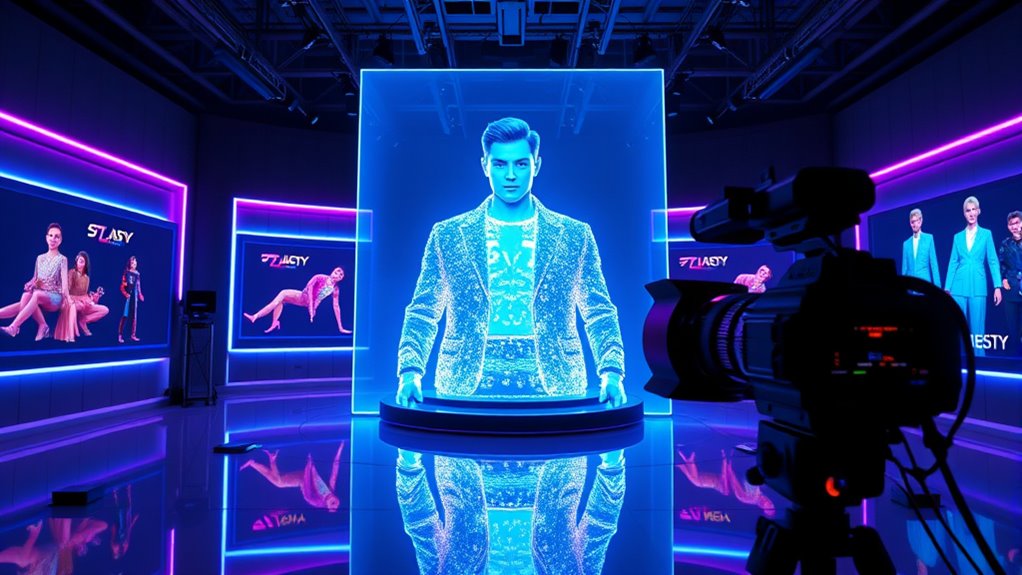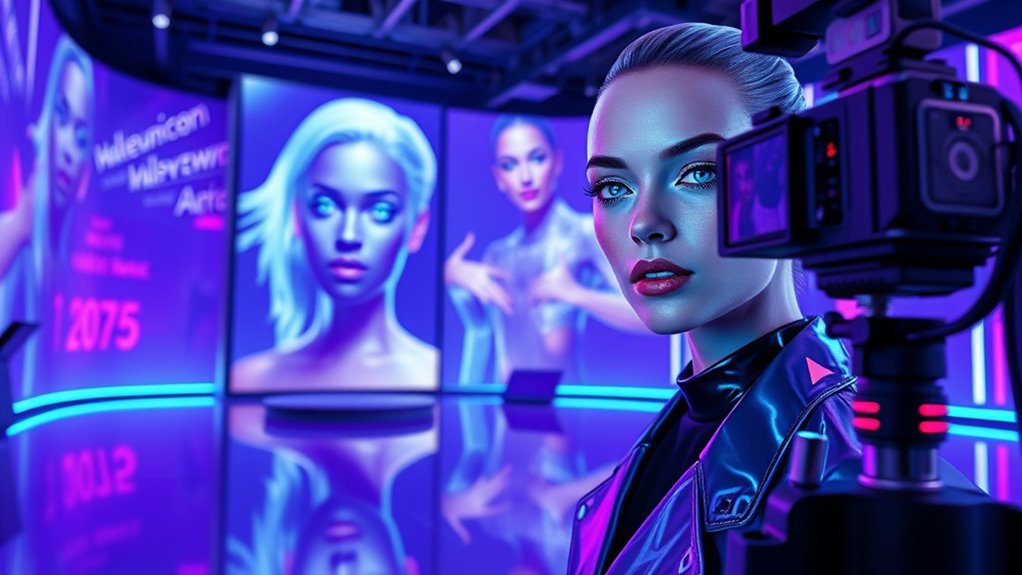By 2025, AI-driven virtual influencers and digital celebrities will transform Hollywood, offering highly realistic, adaptable personalities that reshape how we connect with fame and entertainment. These virtual stars leverage advanced CGI and AI to engage audiences across platforms, often outperforming traditional influencers in reach and engagement. As their presence grows in marketing, gaming, and media, understanding the technology, ethics, and industry trends behind these virtual icons will give you a deeper insight into the future of celebrity culture.
Key Takeaways
- Virtual influencers are transforming Hollywood, enabling 24/7 engagement, enhanced realism, and seamless multimedia integration by 2025.
- AI-driven avatars with emotional intelligence are creating authentic, relatable digital celebrities across social media, music, and film.
- The virtual celebrity market is projected to surpass $8 billion by 2025, driven by brand investments and innovative storytelling.
- Virtual stars like Nobody Sausage and Guggimon demonstrate high influence, often surpassing traditional celebrities in reach and engagement.
- Ethical transparency and data privacy remain critical challenges for maintaining trust and authenticity of AI-powered virtual celebrities.
The Rise of Virtual Influencers in the Entertainment Industry

Have virtual influencers truly begun transforming Hollywood and the entertainment landscape? They’re reshaping how audiences experience celebrity impersonation and virtual authenticity. Unlike traditional stars, these digital personalities can perform 24/7, adapt their personas instantly, and engage fans across multiple platforms. Their realism continues to improve with advances in AI, CGI, and emotional intelligence, making them more convincing and relatable. Virtual influencers are crossing from social media into music, gaming, and film, creating new forms of digital celebrity. They offer brands and creators a flexible, risk-free way to connect with audiences—no scandals, no aging issues. As Hollywood explores integrating these synthetic celebrities into movies and events, you’ll see virtual influencers becoming central figures in entertainment’s future.
Market Growth and Economic Impact of Digital Celebrities

The virtual influencer market is expected to grow rapidly, reaching over $8 billion by 2025 and potentially hitting $154 billion by 2032. This expansion reflects increasing investments in influencer marketing, with brands seeing higher engagement and better ROI from digital celebrities. As the industry evolves, you’ll see more businesses adopting virtual influencers to boost revenue and streamline their marketing efforts. AI security measures will play a vital role in protecting these digital assets from cyber threats and safeguarding sensitive data associated with virtual influencers.
Market Expansion Forecasts
As virtual influencers continue to gain traction, their market is poised for remarkable expansion, fundamentally reshaping the digital celebrity landscape. The industry is projected to reach USD 8.30 billion in 2025, fueled by increasing demand for AI-generated personas that emphasize virtual authenticity. This growth reflects a broader shift towards digital cultural representation, allowing brands to showcase diverse identities and narratives without physical limitations. By 2032, the market could soar to around USD 154.6 billion, driven by a CAGR of 41.29%. As more companies recognize virtual influencers’ potential, they’ll invest in scalable, cost-effective campaigns that resonate globally. This expansion not only boosts economic impact but also pushes the boundaries of cultural inclusion, making virtual influencers powerful tools for authentic digital representation in the digital age.
Influencer Marketing Trends
Virtual influencers are transforming influencer marketing by delivering unprecedented engagement and cost efficiencies. The virtual influencer market is projected to hit USD 8.30 billion in 2025, fueled by AI-driven personas and innovative brand strategies. As this sector grows at a CAGR of over 41%, brands see virtual influencers offering up to 3x higher engagement rates through personalized content and virtual authenticity. You’ll notice how creative storytelling helps these digital celebs connect with audiences on a deeper level, blending entertainment with marketing. Vibe coding techniques are increasingly being used to enhance the authenticity and personalization of virtual influencer content.
- Benefits include cost savings, scalable campaigns, and reduced risk.
- Brands are shifting budgets toward micro-influencers and AI-driven content.
- Virtual influencers are expanding their roles in Hollywood, crossing into music, gaming, and film.
This trend is reshaping how brands interact with audiences, emphasizing emotional connection and authenticity.
Business Revenue Growth
The market for digital celebrities is experiencing explosive growth, driving significant revenue across entertainment, marketing, and branding sectors. You’ll find that virtual authenticity and AI personalization are key drivers, making virtual influencers more relatable and engaging. Brands leverage these personas for high ROI, often seeing up to three times higher engagement rates than human influencers. As AI technology advances, virtual influencers become more realistic, boosting consumer trust and brand loyalty. This growth is reflected in the projected USD 8.30 billion market size in 2025, with a CAGR of 41.29%. Cost-effective and scalable, virtual influencers help brands control messaging and minimize risks. Overall, this economic impact is transforming how companies approach marketing, fueling ongoing revenue growth and opening new revenue streams within a rapidly evolving digital landscape. Philosophical insights on authenticity and existence can deepen understanding of the importance of content authenticity in building consumer trust.
Leading Virtual Influencers and Their Follower Metrics

You’re likely aware that virtual influencers like Nobody Sausage and Guggimon boast millions of followers, showcasing their strong digital presence. These figures highlight how some AI personas surpass traditional influencers in reach and engagement. Examining their follower milestones reveals the growing influence and commercial potential of virtual celebrities in Hollywood and beyond. As these virtual entities become more prevalent, they exemplify the importance of supporting independent sellers in navigating this evolving landscape.
Top Virtual Influencer Stats
Have you ever wondered who the biggest digital stars are in the world of virtual influencers? These virtual icons boast impressive follower metrics, showcasing the power of AI personality and virtual authenticity. For example:
- Nobody Sausage leads with 22.1 million TikTok followers, demonstrating diverse appeal beyond humanoid forms.
- Guggimon commands 11.7 million followers, blending fashion, humor, and multimedia presence.
- Lil Miquela maintains 3.4 million TikTok and 2.5 million Instagram followers, working with luxury brands like Prada and Dior.
- The engagement strategies of these virtual influencers often incorporate multi-functional content, enhancing their appeal across platforms and audiences.
These stats highlight how virtual influencers engage audiences through crafted AI personalities, emphasizing authenticity despite their digital origins. As technology advances, their follower numbers continue to grow, proving their influence in shaping digital culture and marketing strategies.
Notable Follower Milestones
Leading virtual influencers have achieved remarkable follower milestones that underscore their growing influence across social media platforms. For instance, Nobody Sausage boasts over 22 million TikTok followers, showcasing AI-driven content’s appeal. Guggimon’s 11.7 million TikTok followers highlight the blend of fashion, humor, and multimedia branding. Barbie’s virtual persona commands 3.5 million Instagram followers, earning significant revenue from celebrity endorsements, with sponsored posts averaging $15,400. These milestones reflect not only technological advancements but also the ongoing debate around AI ethics, especially regarding transparency and authenticity. As virtual influencers reach new heights, brands must balance leveraging celebrity endorsements with maintaining consumer trust, ensuring that their digital stars resonate genuinely with diverse audiences. The increasing popularity of virtual influencers also emphasizes the importance of understanding content creation and audience engagement strategies in the evolving digital landscape. These follower milestones demonstrate virtual influencers’ increasing social influence and commercial viability in 2025.
Advances in Technology and Realism Enhancing Virtual Personas
Advances in AI, CGI, and deep learning are revolutionizing how virtual influencers appear and interact with audiences, making them more lifelike and emotionally intelligent than ever before. These technological strides boost virtual authenticity, allowing digital personas to convey genuine emotions and nuanced responses. AI creativity enables creators to craft complex characters that adapt in real-time, engaging followers with personalized content. Platforms like Unreal Engine and MetaHuman Creator empower you to design highly expressive, detailed avatars capable of subtle gestures and reactions. This progress opens new doors for immersive experiences, blending virtual personas seamlessly into social media and metaverse environments. You’ll see virtual influencers breaking creative boundaries and establishing stronger emotional connections through enhanced realism, making them more convincing and relatable than ever. Additionally, the integration of real-time emotional responsiveness driven by AI enhances the sense of genuine interaction, further blurring the lines between virtual and reality.
Brand Adoption Strategies and Industry Trends

As brands increasingly recognize the potential of virtual influencers, they are adopting diverse strategies to integrate these digital personas into their marketing campaigns. They focus on ensuring virtual authenticity by developing detailed, relatable characters that resonate with audiences. Creative storytelling plays a vital role, allowing brands to craft compelling narratives around their virtual ambassadors, making campaigns more engaging and memorable. Many are shifting budgets toward micro and mid-tier creators, seeking authentic connections over sheer follower counts. While concerns about consumer trust persist—causing some hesitation—brands are exploring immersive experiences and real-time interactions to build credibility. Additionally, understanding private placement equity markets can enable brands to secure strategic investments and funding for their virtual influencer initiatives. Overall, industry trends show a move toward more nuanced, scalable digital marketing efforts that blend technological innovation with authentic, emotionally resonant storytelling.
Virtual Celebrities in Hollywood and Multimedia Campaigns

Virtual celebrities are rapidly expanding beyond social media into Hollywood and multimedia campaigns, transforming how brands and creators engage audiences. Their virtual identity allows them to perform seamlessly across films, music videos, and gaming, offering endless creative possibilities. You’ll see these digital stars being used as brand ambassadors, blending celebrity branding with innovative storytelling. They’re not limited by physical constraints, making them ideal for immersive experiences and real-time interactions. Additionally, the integration of digital stars into various media formats enhances audience engagement and opens new avenues for creative expression.
Challenges and Consumer Perception of AI-Generated Stars

Despite the impressive growth of AI-generated stars in Hollywood and digital marketing, consumers remain skeptical about their authenticity and trustworthiness. Public skepticism is driven by doubts over whether virtual influencers are genuinely relatable or simply marketing tools. Many worry about ethical transparency, questioning if brands are clear about AI origins and content creation processes. This mistrust can hinder virtual stars’ long-term success, as audiences seek genuine connections. Critics argue that without transparency, virtual influencers risk being seen as artificial or manipulative, diminishing their appeal. To overcome these challenges, brands must prioritize openly communicating the AI nature of these stars and demonstrate authentic engagement. Building trust is essential for virtual influencers to sustain relevance and reshape consumer perception in this rapidly evolving landscape.
Ethical Considerations and Transparency in Virtual Influencer Content

Are brands and creators doing enough to guarantee transparency around virtual influencer content? Many still struggle with authenticity concerns and data privacy issues. You need clear disclosures to let audiences know when they’re engaging with AI-generated personas. Without transparency, trust erodes, and skepticism grows. To address this, consider these steps:
- Clearly label virtual influencers as AI or CGI to maintain authenticity.
- Share details about data privacy measures protecting follower information.
- Provide behind-the-scenes insights into how virtual personas are created and managed.
Future Outlook and Opportunities for AI-Driven Digital Celebrities

As AI technology continues to advance, the future of digital celebrities presents immense opportunities for brands and creators alike. You’ll see virtual identities becoming more sophisticated, blending hyper-realism with emotional intelligence to foster genuine connections. AI authenticity will play a key role, enabling virtual influencers to build trust through transparent storytelling and consistent behavior. This evolution opens doors for personalized marketing campaigns that resonate deeply with diverse audiences. You can expect virtual celebrities to expand into new entertainment sectors, including virtual concerts, gaming, and film. As AI-driven avatars become more immersive and responsive, brands will leverage them for scalable, cost-effective engagement. Overall, the future holds a dynamic landscape where virtual identities redefine celebrity culture, blending technological innovation with authentic audience experiences.
Frequently Asked Questions
How Do Virtual Influencers Maintain Audience Trust Over Time?
You maintain audience trust over time by consistently engaging them through authentic interactions and transparent content. Focus on building genuine audience engagement, showing real emotions, and being honest about the AI nature of your virtual influencer. By fostering a perception of authenticity, followers feel connected and valued, which helps sustain trust. Regularly updating your persona and listening to feedback guarantees your virtual influencer remains relatable and trustworthy in the eyes of your audience.
What Legal Rights Do Virtual Celebrities Have?
You need to understand that virtual celebrities don’t have legal rights like humans do, but their creators hold the intellectual property rights. Ethical considerations also come into play, especially around transparency and authenticity. If you use or modify their digital personas, you must respect copyright laws and make sure you’re not infringing on someone else’s intellectual property. Staying aware of these legal and ethical boundaries helps protect your brand and maintains trust with your audience.
How Do Brands Measure ROI From Virtual Influencer Campaigns?
Think of measuring ROI from virtual influencer campaigns as steering a ship through data waves. You track brand engagement metrics, like follower growth, interaction rates, and conversions, alongside campaign analytics, to gauge success. By analyzing these indicators, you see how well your virtual influencer sparks interest, builds loyalty, and drives sales. This data guides you to optimize future strategies, ensuring your digital voyage yields maximum return on investment.
Can Virtual Influencers Adapt to Real-Time Cultural Trends?
Yes, virtual influencers can adapt to real-time cultural trends by leveraging AI-driven trend responsiveness and cultural sensitivity. You can program them to analyze social media signals, popular hashtags, and current events, allowing quick updates to their personas and content. This agility helps maintain relevance, engage diverse audiences, and reflect evolving cultural nuances, making virtual influencers effective tools for brands seeking timely, authentic connections in a dynamic digital landscape.
What Are the Risks of Over-Reliance on AI Personalities?
Relying too heavily on AI personalities risks turning your brand into a shiny puppet, losing genuine human connection. Ethical concerns and authenticity challenges lurk like shadows, threatening trust and credibility. As virtual influencers become more convincing, you might find your audience questioning what’s real, risking alienation. Over-dependence could backfire, making your message feel hollow, like a echo in a digital canyon. Balance AI innovation with real human touch to keep trust alive.
Conclusion
As you explore the evolving world of virtual influencers, you’ll find endless opportunities blooming quietly behind the scenes. While these digital celebrities continue to shape Hollywood’s landscape, it’s worth embracing their subtle influence with curiosity and openness. As technology gently advances, expect your favorite stories and campaigns to become more immersive and innovative. By staying informed, you’ll enjoy this enthralling digital journey, where the future feels both promising and beautifully understated.








